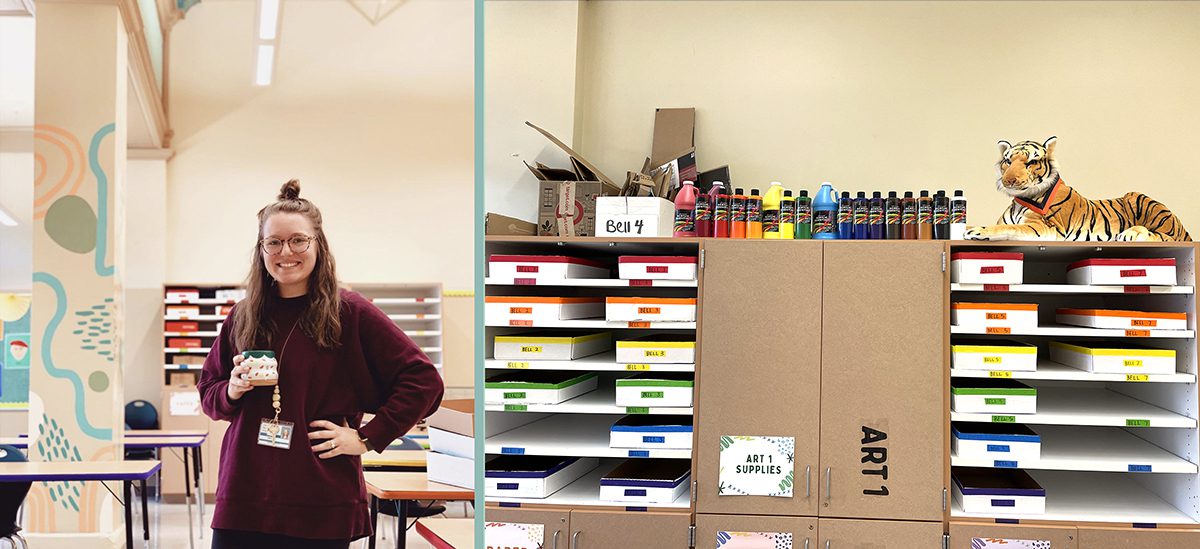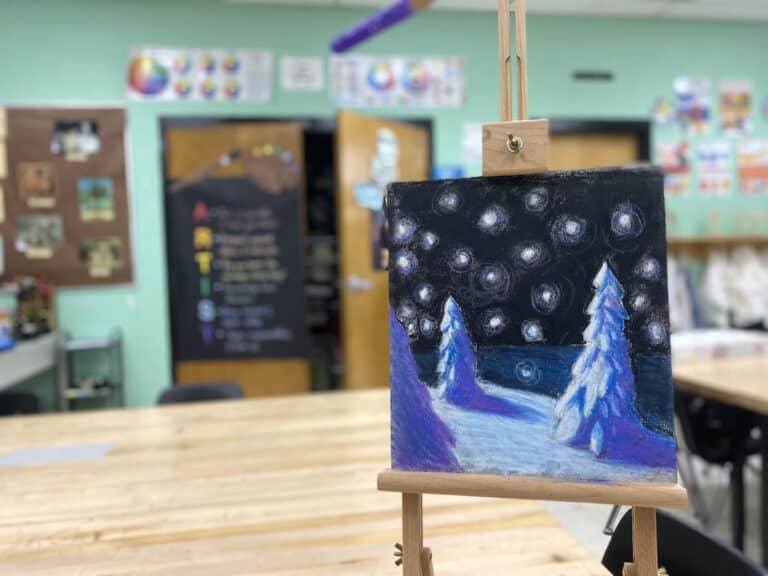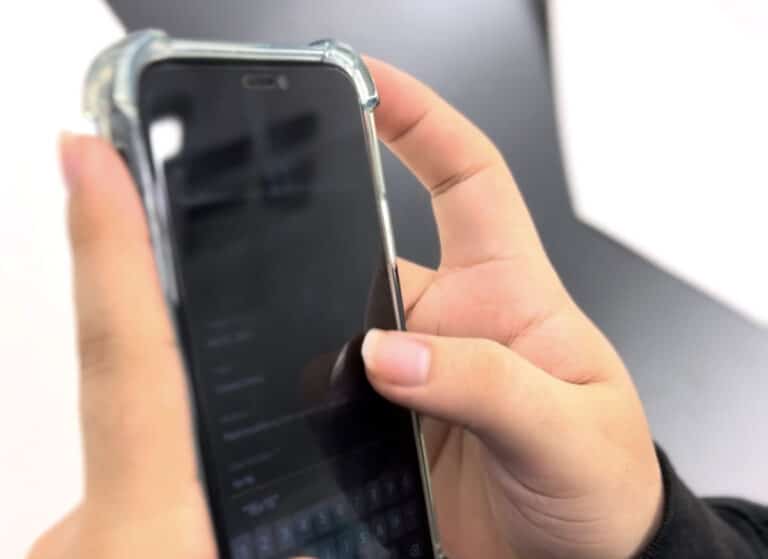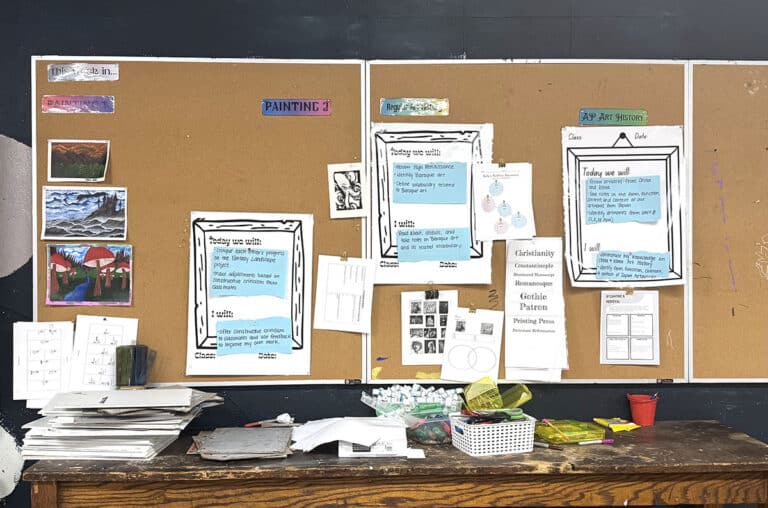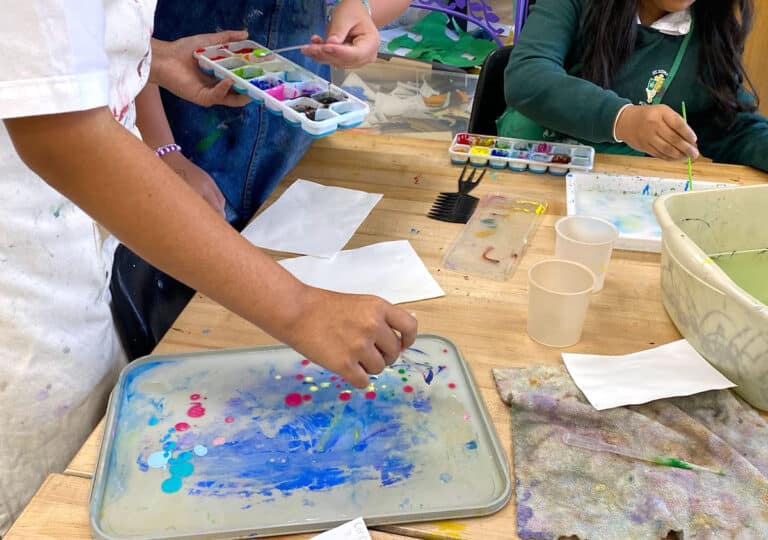Starting a new school year can feel overwhelming. Teachers have to think about curriculum, standards, expectations, and supply orders (to name a few). On top of all that, decorating your classroom might feel like too much to take on. It takes extra effort to consider how the classroom meets the creative needs of both the teacher and students. Let’s take a moment to consider how classrooms might be a place of comfort and inspiration. How can we tackle our rooms with the intention to make them a creative sanctuary this year?
What is comfort decorating?
We spend a lot of time within the walls of our art rooms. It is second only to our own homes. The places we spend the most amount of time have a significant impact on our mindset. During the height of the pandemic, people spent a lot of time at home. This caused them to rethink their personal spaces. Many engaged in a practice called comfort decorating. This is a practice where a person makes their space more calming through the consideration of color, objects, and organization. Design professionals assert a boost in our mood when there is a sense of control over space.
We can make our personal spaces a sanctuary of escape and creativity. I have a friend who referred to her art room as “The Creative Sanctuary.” She used this terminology with everyone within the building. She politely corrected them when they used the term “art room.” This may seem unique, but it was a way to reframe the conversation about her art room.
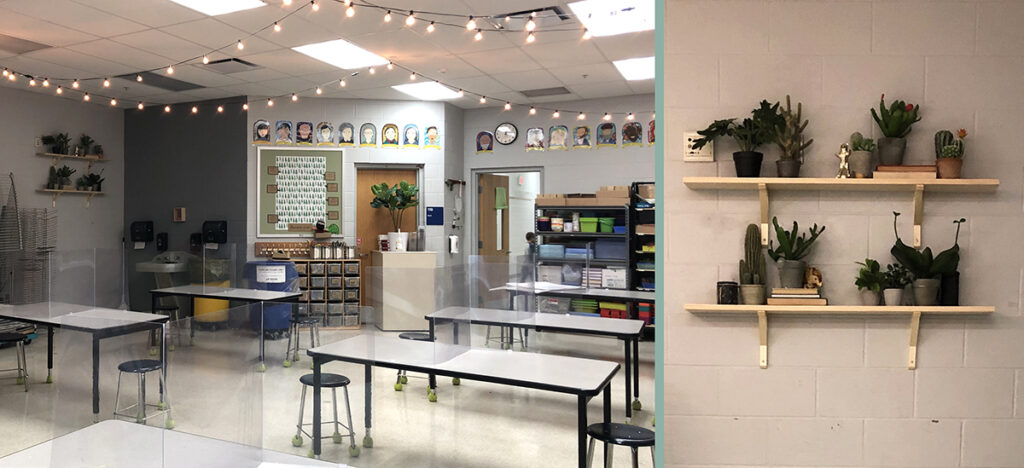
What if I don’t have a classroom?
Good news! You do not need a classroom to make a sanctuary for your students. You can make your cart or office a welcoming place that nurtures creativity. Many of the tips below can still apply to you.
Here are some cart-specific resources to look into:
- The Anatomy of an Art Cart
- Tips for Teaching Art on a Cart From a Seasoned Pro
- Top 10 Tips to Start Teaching Art-From-A-Cart
- Tips and Tricks for Teaching on a Cart (Ep. 227)
- Teaching Art on a Cart in 2021: Part 1 (Ep. 187)
- Teaching Art on a Cart in 2021: Part 2 (Ep. 188)
- Getting Started Teaching Art on a Cart PRO Pack
- How to Work Smarter Not Harder with Art on a Cart This Year
- More Ideas for Teaching Art on a Cart (Ep. 243)
Here are five tips to make our art rooms a sanctuary of creativity.
1. Color matters.
We know color matters—we are art teachers. The colors included in an art piece can elicit warmth, calm, energy, anger, or joy. The same is true of our art rooms. Many art teachers use rainbows and bright colors. The high energy works for them and their students. But if a wall of rainbows does not feel comfortable for you, then do something else. Experts in the field of comfort decorating suggest earthy greens to foster a sense of calm.
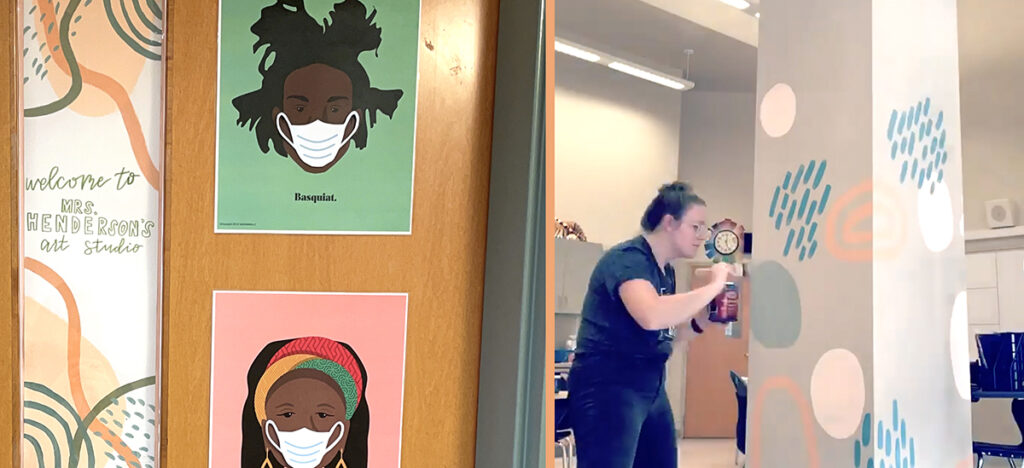
Emily Henderson, a new high school art teacher, stepped into her room last year for the first time. The room was bright and light. She thought to herself, “This is the prettiest room in the world. Now how do I make it my own?” She settled on a muted palette she refers to as a neutral rainbow. These colors are in murals on the pillars in her art room and are also included in her own home.
2. Consider the cabinets.
One of the first things any art teacher takes note of in an art room is the storage. We are collectors of things and our management of materials can be a full-time job. But those cabinets offer a lot of opportunities.
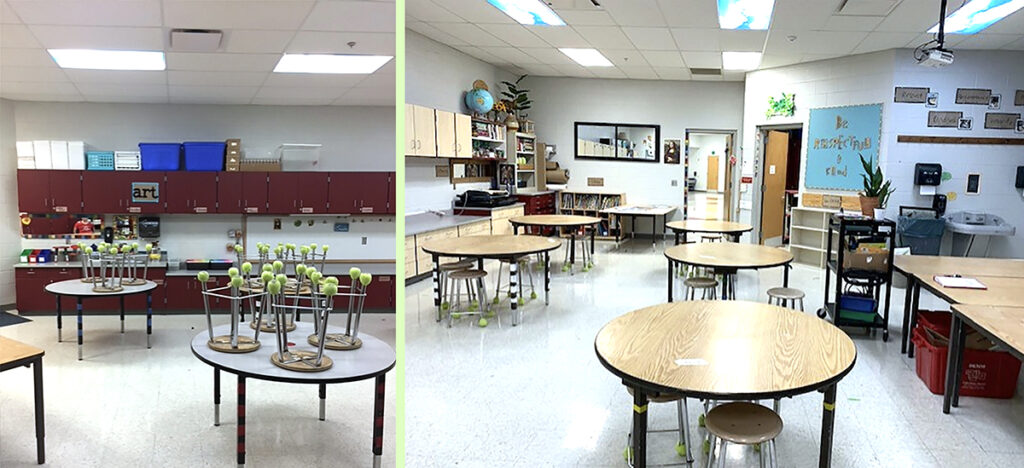
Elementary art educator Casie Fanning enjoys classrooms designed with a Reggio Emilia approach. This approach emphasizes wood grain and natural elements. But this is not the space she had. Casie received a windowless room with dark red cabinets. “Instead of feeling defeated, I began to start dreaming big and looking for creative solutions to change my space,” reflected Casie. And her efforts started with covering the cabinets with wood grain contact paper. It was a time-consuming process, but the end product was a brighter space. It now reflects her personal style and teaching philosophy.
Rob Jones is an elementary art teacher who used tempera paint to turn his cabinets into an area of inspiration. In large black letters he painted, “We make mistakes here, (and it is okay).” This artist-educator reflects, “I tell my students, anything can be a canvas, right?”
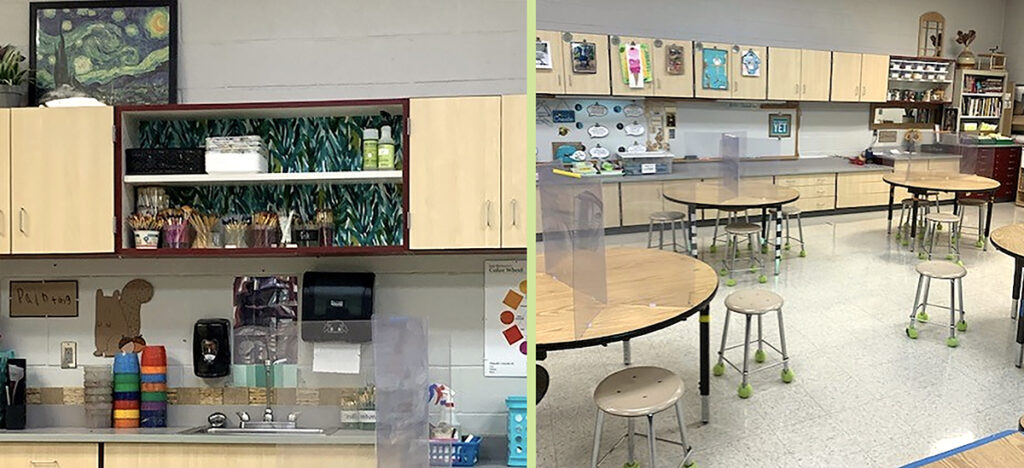
Some of us shove materials away in cabinets to get the supplies out of sight. But what if more of those cabinets were open shelves? Open shelving allows both teachers and students to see and access necessary supplies. Both Emily Henderson and Casie Fanning removed cabinet doors to make items more accessible. Casie decided to go a step further. She covered the backs of the cabinets with a leafy self-adhesive wallpaper to add a pop of pattern. Even the backs of the cabinets prompt inspiration.
3. Keep up with organization.
Donations are wonderful. All someone has to say is, “Would you like…” and items begin to pile up! You might receive items like bags of plastic caps or forty-two egg cartons. We don’t know how it happens, but it does. It can be exciting and overwhelming to welcome these new treasures into our space. Rob Jones said that he still struggles with organization even after twelve years in his classroom. Don’t let bags of donations pile up. Instead, immediately choose a place for things you will keep. Let go of the things you don’t want or need. It’s okay.
Focusing on organization is for both you and your students. Systems of consistent organization offer a sense of calm and also inspire creativity. Emily Henderson has her classroom cabinets divided in two. There are cabinets for students to access supplies. Specific items are further labeled by course.
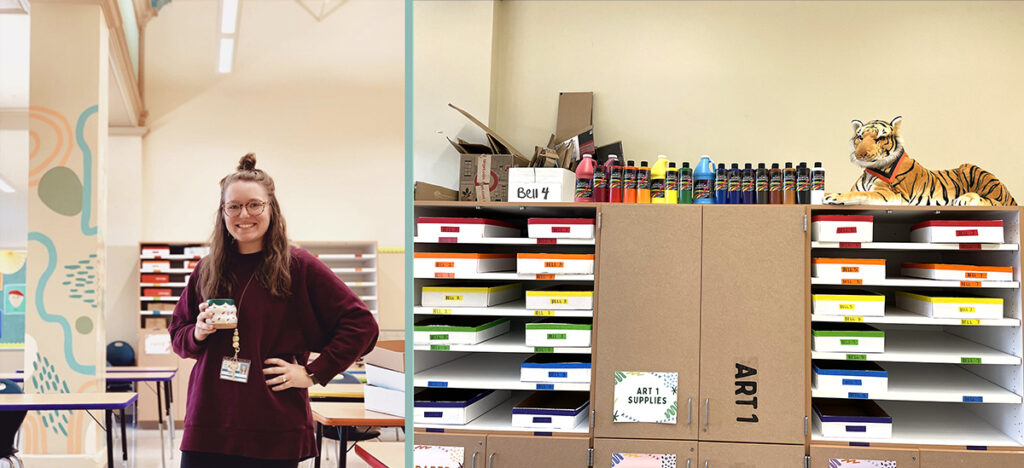
At Emily Henderson’s high school, a quarter of the students are English Language Learners. She decided to label the supplies in both English and Spanish. Another idea is to use open shelving. This allows students to see the supplies without having to read the labels on cabinet doors.
4. Incorporate inspirational items.
Our art rooms are full of items that spark the imagination. Items like picture books, posters, or giant pencils inspire students. Take a minute to examine the items accumulated in your art room. Do they bring inspiration? Or are they only taking up space?
Sometimes we need to be innovative with our inspirational items. Casie Fanning loves connecting to nature. For example, she fills her home with houseplants. But, in her windowless classroom, she needs to bring in artificial plants instead.
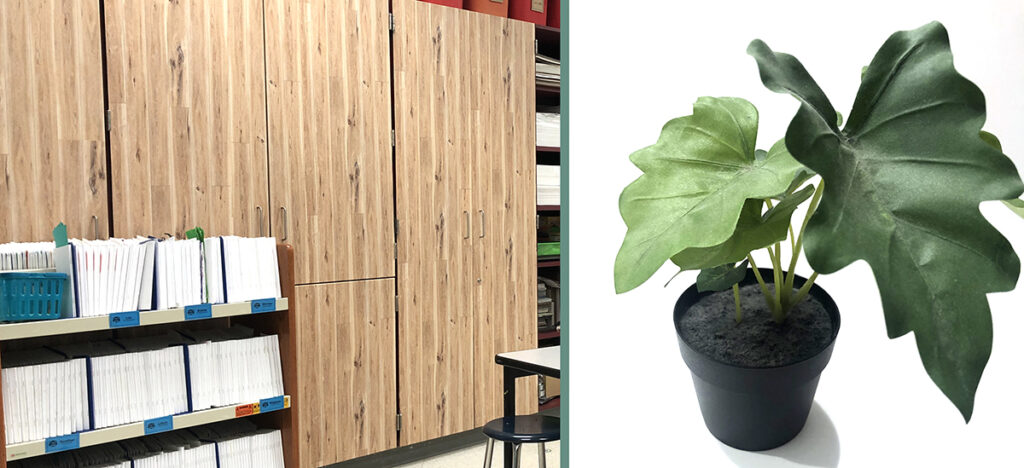
Rob Jones reminds us that the space we create also includes sound. There is a beautiful noise that students create while working. The songs we curate for students to listen to while they work can inspire artmaking. Rob’s room reverberates with jazz, classical, and world music.
Students find inspiration when teachers value their work. Casie Fanning employs her young students to create labels for materials and her TAB-based studios. As much as she wants the space to function for her as an adult, she seeks to focus on students and their needs. Students love seeing their work on display. Rob Jones has a dedicated bulletin board for artwork. His students create at home and then bring their work to school.
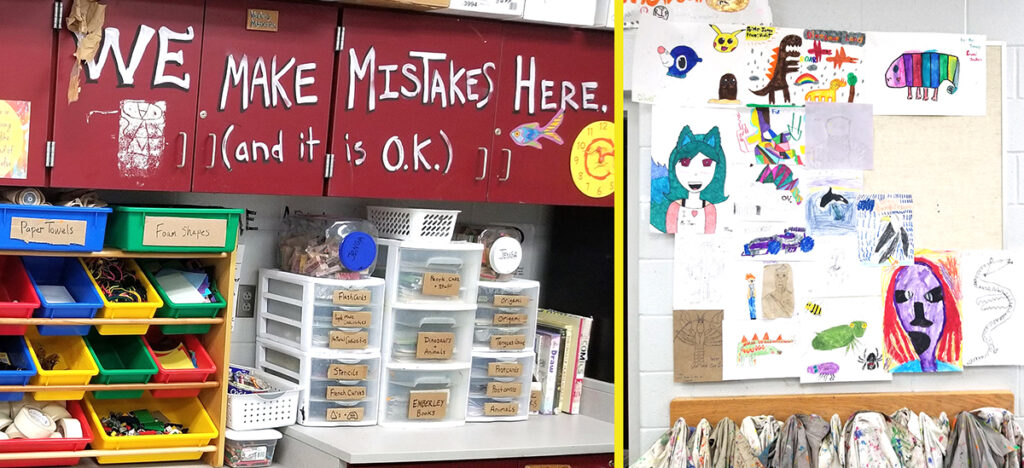
5. Make your own space.
Classrooms can function as a sanctuary for students, but they can also be a sanctuary for us. Rob Jones has a personal studio workspace within the art room, which he looks at as an extension of his home studio. Here, he creates his own art. He demonstrates to students that he is a practicing artist as well as their teacher. Having our own spaces can also be a means of self-regulation. He notes, “It is a place where I can catch my breath for a moment and regroup.”
What if something isn’t working?
It is worth remembering that nothing is perfect. We may make intentional decisions that later change based on our day-to-day experience. And that is okay. Rob Jones states, “If something isn’t working, change it.” Emily Henderson painted a color block mural over a row of sinks. After she took a second look at it, she felt the mural was too busy and visually overwhelming. She plans on repainting it in the future. She reflects,
“It probably doesn’t impact anyone else who spends time in my room but me, but I’m here all day long looking at the wall. I believe it is the little details that make a difference.”
Casie Fanning strives to never stop making modifications to her art room. Each new solution prompts another idea or another method of organization. Being open to change is essential in envisioning an inspiring art room. Our student’s needs are also ever-changing.
It is also important to note that this is not a one-stop project that can be done in a day or two of teacher in-service. Sanctuaries take time to ideate and implement. Pace yourself and give yourself grace if you need to take a pause on the process. Back to school is a crazy time of year with a million and one things to do.
There is a lot to consider when dreaming up our classrooms. They serve as a creative sanctuary for both our students and ourselves. We have to remember that what matters most are the humans in the art room. Emily Henderson shares, “Your students are there for you and art. They are not there for the ‘Pinterest-worthy’ classroom or the Instagram pictures. It isn’t about the room, but it is about the teacher who loves art and their students.”
What is one way you can make your art room a creative sanctuary for you as the teacher?
Think of an art room have you always admired. What are your favorite parts and why?
What is one method of organization you have implemented that elicits a sense of calm? What is one method that needs updating?
Magazine articles and podcasts are opinions of professional education contributors and do not necessarily represent the position of the Art of Education University (AOEU) or its academic offerings. Contributors use terms in the way they are most often talked about in the scope of their educational experiences.

